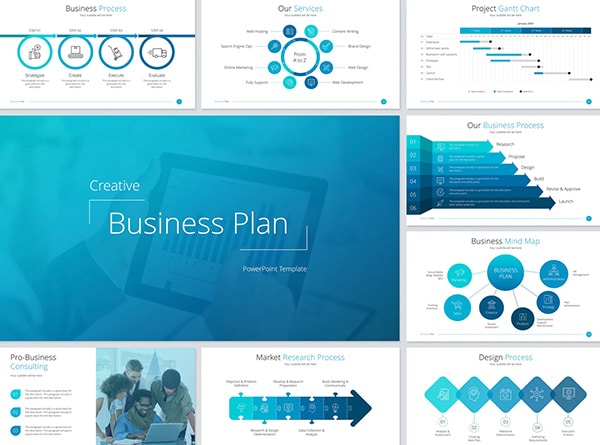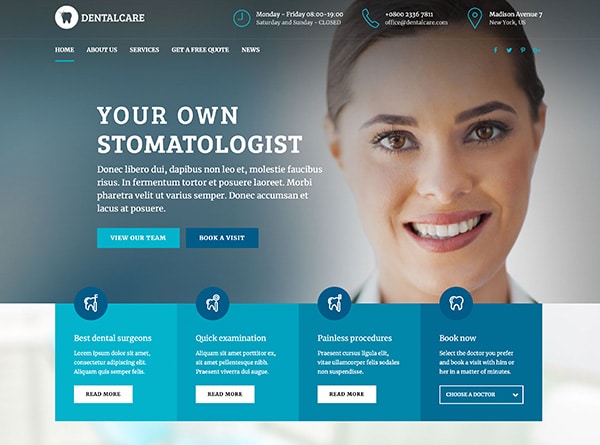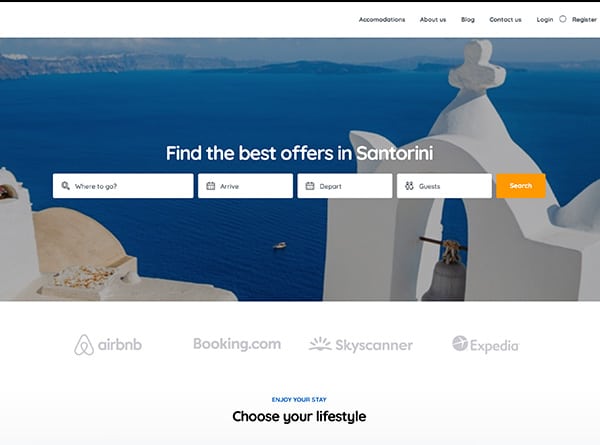
More and more businesses are creating websites in order to gain customers and market their products and services. However, with tons of websites releasing on the internet every day, having a great website isn’t enough; it needs to stand out among dozens or even hundreds of other websites in your industry. It needs to be unique and engaging—an eye-catching site that will draw people in and make them want to learn more.
In this blog post, we’ll discuss some of the ways that you can make your website stand out from the crowd. We’ll go over design, content, branding, and more – so let’s get started!
1. Become a Content Machine
If you want your website to stand out from the rest, you need to create a content machine. That means regularly churning out new, fresh, and most significantly, valuable content that’s relevant to your target audience. Whether you are in the product or service industry, you need to bring out content on a regular basis to stay at the top of your field. So, how do you do that?
Here are some tips:
- Plan ahead.
Decide on a regular schedule for creating and publishing new content, and stick to it. This will help you stay consistent and avoid feeling overwhelmed. Planning ahead allows you to map out your content strategy, ensuring that you cover all necessary topics and maintain a steady flow of information to your audience. - Batch your content creation. If you can, sit down and write several pieces at once instead of starting from scratch each time you need to publish something new. This will save you time and help you maintain a steadier output. By batching your content creation, you can focus on writing without interruptions, leading to higher quality and more cohesive content.
- Repurpose old content. If you’re struggling to come up with new ideas, take a look at your older blog posts and articles. Can you update them with new information or perspectives? This is a great way to keep your content feeling fresh without starting from scratch every time. Repurposing old content can also help you reach new audiences who may have missed the original posts.
- Leverage guest writers or experts. If writing isn’t your strong suit or you simply don’t have the time to produce all the content yourself, consider reaching out to guest writers or experts in your field who can contribute quality pieces to your site. Guest writers can bring new perspectives and expertise, adding value to your content and attracting a wider audience.
In addition to traditional written content, don’t forget about other types of media like images, infographics, videos, and so on. These can help break up longer pieces of text and add another layer of engagement for your audience. Visual content can make your website more appealing and easier to digest, keeping visitors on your site longer. - Make use of visuals. High-quality visuals can significantly enhance the appeal of your content. Use images, infographics, and videos to complement your written content and make it more engaging. Visuals can help illustrate complex ideas, making them easier for your audience to understand.
2. Use Stunning Videos and Images
Using high-quality videos and images on your website can make a big difference in how it looks to visitors. Here are some tips:
- Choose eye-catching, high-resolution images and videos that fit with your brand. High-quality visuals can make your website look more professional and appealing. Ensure that the images and videos you use are relevant to your content and align with your brand’s aesthetic.
- Make sure your site’s design highlights the visuals, rather than overwhelming them. Your website’s design should complement your visuals, not overshadow them. Use a clean, simple layout that allows your images and videos to stand out.
- Use attention-grabbing visuals in key areas, such as the home page and landing pages. The home page and landing pages are often the first places visitors see when they arrive at your site. Use striking visuals in these areas to make a strong first impression and encourage visitors to explore further.
- Think about what kind of emotions you want to evoke in your visitors, and choose visuals that support that goal. The images and videos you use should align with the emotions you want to evoke in your audience. Whether you want to inspire, inform, or entertain, choose visuals that help convey your message effectively.
- Incorporate unique visuals into your website design. Using unique visuals can help set your website apart from the competition. Consider using custom graphics, illustrations, or animations to create a distinctive look and feel for your site.
3. Optimize for Mobile
more people are accessing websites from their mobile devices than ever before. Therefore, it’s crucial to ensure that your website is optimized for mobile. A mobile-friendly website not only improves the user experience but also boosts your search engine rankings.
Here are some tips for optimizing your website for mobile:
- Use a responsive design. A responsive design ensures that your website looks great on all devices, from desktops to smartphones. This means that your site will automatically adjust its layout and content to fit the screen size of the device being used.
- Simplify your navigation. Mobile users should be able to navigate your site easily. Use a simple, intuitive navigation menu that allows users to find what they’re looking for quickly and easily.
- Optimize your images and videos. Large images and videos can slow down your site’s loading time, which can be frustrating for mobile users. Optimize your visuals to ensure that they load quickly without compromising quality.
- Use readable fonts. Make sure that the fonts you use are easy to read on smaller screens. Avoid using small or overly decorative fonts that can be difficult to read on mobile devices.
- Test your site on multiple devices. Before launching your site, test it on various devices to ensure that it looks and functions as intended. This will help you identify and fix any issues that may arise.
4. Improve Your Site’s Loading Speed
A fast-loading website is essential for providing a positive user experience. If your site takes too long to load, visitors may become frustrated and leave before they even have a chance to see your content. Here are some tips for improving your site’s loading speed:
- Optimize your images. Large image files can significantly slow down your site’s loading time. Use image optimization tools to reduce the file size of your images without compromising quality.
- Minimize HTTP requests. Each element on your web page, such as images, scripts, and stylesheets, requires an HTTP request to load. Minimize the number of HTTP requests by combining files and using CSS sprites.
- Enable browser caching. Browser caching allows your site’s static files to be stored on a user’s device, so they don’t have to be reloaded each time the user visits your site. This can significantly reduce loading times for returning visitors.
- Use a content delivery network (CDN). A CDN distributes your site’s content across multiple servers around the world, allowing users to access your site from the server closest to them. This can help reduce loading times and improve the overall performance of your site.
- Minify CSS, JavaScript, and HTML. Minifying your site’s code involves removing unnecessary characters, such as spaces and comments, to reduce file size and improve loading speed.
5. Enhance Your Site’s SEO
Search engine optimization (SEO) is crucial for driving organic traffic to your website. By optimizing your site for search engines, you can improve your rankings and attract more visitors. Here are some tips for enhancing your site’s SEO:
- Conduct keyword research. Identify the keywords and phrases that your target audience is searching for, and incorporate them into your content. Use tools like Google Keyword Planner or SEMrush to find relevant keywords.
- Optimize your on-page elements. Ensure that your title tags, meta descriptions, headers, and URLs are optimized for your target keywords. Use descriptive, keyword-rich titles and meta descriptions to improve your site’s visibility in search engine results.
- Create high-quality content. Search engines prioritize high-quality, relevant content. Focus on creating informative, engaging content that provides value to your audience. Regularly update your site with fresh content to keep it relevant and improve your rankings.
- Build backlinks. Backlinks from reputable websites can significantly improve your site’s SEO. Reach out to other websites in your industry and ask for backlinks, or create shareable content that others will want to link to.
- Optimize for local search. If your business has a physical location, optimize your site for local search by including your address, phone number, and business hours on your site. Claim your Google My Business listing and encourage customers to leave reviews.
6. Focus on User Experience
Providing a positive user experience is essential for keeping visitors on your site and encouraging them to return. Here are some tips for improving your site’s user experience:
- Use a clean, simple design. A cluttered, confusing design can be overwhelming for visitors. Use a clean, simple layout that makes it easy for users to find what they’re looking for.
- Ensure your site is easy to navigate. Use a clear, intuitive navigation menu that allows users to find information quickly and easily. Include a search bar to help users find specific content.
- Make your content easy to read. Use short paragraphs, bullet points, and headings to break up your content and make it easier to read. Use a readable font and ensure that your text is large enough to be read on all devices.
- Include clear calls to action. Encourage visitors to take action by including clear, compelling calls to action throughout your site. Whether you want users to sign up for a newsletter, make a purchase, or contact you, make it easy for them to do so.
- Test your site regularly. Regularly test your site to identify and fix any issues that may arise. Use tools like Google Analytics to track user behavior and identify areas for improvement.
By following these tips, you can create a website that stands out from the crowd and attracts more visitors. Remember, a successful website is one that provides value to its audience, is easy to navigate, and offers a positive user experience. Keep these principles in mind as you work to improve your site, and you’ll be well on your way to achieving your goals.
7. Use Proper Analytics
Be friends with analytics. You need to make sure you’re using proper analytics tools to track your website’s traffic and engagement. Understanding your audience’s needs and wants is crucial. By doing this, you’ll be able to see what’s working well on your website and what areas need improvement. You can also use this data to create targeted content and marketing campaigns that will appeal to your audience. So, if you’re not already using analytics on your website, now is the time to start. It could be the difference between having a successful website and one that gets lost in the crowd.
Here are some tips for using analytics effectively:
- Set clear goals. Before diving into analytics, define what you want to achieve. Are you looking to increase traffic, improve engagement, or boost conversions? Setting clear goals will help you focus on the metrics that matter most.
- Use the right tools. There are many analytics tools available, such as Google Analytics, that can provide valuable insights into your website’s performance. Choose the tools that best fit your needs and make sure you’re using them to their full potential.
- Track key metrics. Focus on the metrics that align with your goals. For example, if you want to increase traffic, track metrics like page views, unique visitors, and referral sources. If you’re looking to improve engagement, monitor metrics like bounce rate, average session duration, and pages per session.
- Analyze your data. Regularly review your analytics data to identify trends and patterns. Look for areas where your website is performing well and areas that need improvement. Use this information to make data-driven decisions and optimize your site.
- Create actionable reports. Generate reports that highlight key insights and recommendations. Share these reports with your team to ensure everyone is on the same page and working towards the same goals.
- Test and iterate. Use your analytics data to test different strategies and see what works best. Continuously iterate and optimize your website based on the insights you gain from your analytics.
8. Optimize Your Website for All Search Engines, Not Just Google
If you want your website to be successful, you need to make sure it is optimized for all search engines, not just Google. While Google is the most popular search engine, there are others out there that are also used by people looking for information.
Some tips for optimizing your website for all search engines include:
- Use keyword-rich titles and descriptions. Ensure that your titles and descriptions contain relevant keywords that people are likely to search for. This will help improve your site’s visibility across different search engines.
- Make sure your site is easy to navigate. A well-structured website with clear navigation helps search engines understand your content better. Use a logical hierarchy and include internal links to make it easy for both users and search engines to find your content.
- Use alt tags on images. Alt tags provide a text description of images, which helps search engines understand what the images are about. This can improve your site’s visibility in image search results.
- Submit your site to directories. Submitting your site to online directories can help improve your search engine rankings. Look for reputable directories that are relevant to your industry and submit your site for inclusion.
- Promote your site on social media. Social media can drive traffic to your website and improve your search engine rankings. Share your content on social media platforms and encourage your followers to engage with it.
By following these tips, you can make sure your website is visible to people using all different types of search engines.
9. Engage with Your Customers
There are a number of ways to engage with your customers on your website. Here are a few ideas:
- Use social media tools to connect with your customers and encourage them to interact with your brand. This can be done through features such as Facebook comments or Twitter hashtags. Social media provides a platform for real-time interaction, allowing you to respond to customer inquiries and feedback promptly.
- Use customer testimonials and reviews to show that you value your customers’ opinions. Not only will this help to build trust, but it will also give potential customers an insight into what others think of your business. Displaying positive testimonials and reviews prominently on your site can enhance your credibility and attract new customers.
- Offer customer support through live chat, email, or phone. This will give visitors the reassurance that they can get help if they need it, and it will also give you an opportunity to upsell or cross-sell products and services. Providing multiple support channels ensures that customers can reach you in the way that is most convenient for them.
By engaging with your customers on your website, you’ll be able to build relationships, trust, and loyalty – all of which are essential for any successful business.
10. Identify Your Brand’s Personality and Values
When you are creating a website, one of the most important aspects to consider is the overall personality and values of your brand. This will help dictate the overall tone and style of your site, as well as the types of content that you include.
- To start, sit down and brainstorm what exactly your brand represents. What are its core values? What does it stand for? Do you want a clean and modern look that reflects your professionalism? Or do you want a fun and playful design that showcases your creativity?
Here are some steps to help you identify your brand’s personality and values:
- Define your brand’s mission and vision. What is the purpose of your brand? What do you hope to achieve? Your mission and vision statements should reflect your brand’s core values and guide your overall strategy.
- Identify your target audience. Who are you trying to reach with your website? Understanding your audience’s needs, preferences, and behaviors will help you create a site that resonates with them.
- Choose a brand voice. Your brand voice should reflect your brand’s personality and values. Whether you want to be seen as professional, friendly, authoritative, or approachable, your brand voice should be consistent across all your content.
- Create a visual identity. Your website’s design should reflect your brand’s personality and values. Choose colors, fonts, and imagery that align with your brand’s aesthetic and create a cohesive look and feel.
- Develop a content strategy. Your content should support your brand’s mission and vision. Create content that is relevant, valuable, and engaging for your target audience. Use your brand voice consistently across all your content to reinforce your brand’s personality.
By identifying your brand’s personality and values, you can create a website that truly represents your brand and resonates with your audience.
11. Leverage Animation and Interactivity
Animation and interactivity can help bring your content to life and make it more engaging for visitors. These elements can capture attention, convey information more effectively, and create a memorable user experience.
Here are some tips for using animation and interactivity on your website:
- Use animations to highlight key information. Animations can draw attention to important content, such as calls to action or special offers. Use subtle animations to guide users’ attention without overwhelming them.
- Incorporate interactive elements. Interactive elements, such as quizzes, polls, and interactive infographics, can engage users and encourage them to spend more time on your site. These elements can also provide valuable insights into your audience’s preferences and behaviors.
- Ensure animations and interactive elements are mobile-friendly. Make sure that your animations and interactive elements work well on all devices, including smartphones and tablets. Test these elements on different devices to ensure a smooth user experience.
- Use animations to enhance storytelling. Animations can help tell your brand’s story in a more engaging and dynamic way. Use animations to illustrate key points, demonstrate product features, or create a narrative that resonates with your audience.
- Keep it simple. While animations and interactivity can enhance your website, it’s important not to overdo it. Use these elements sparingly and ensure they complement your content rather than distract from it.
By leveraging animation and interactivity, you can create a more engaging and memorable experience for your website visitors.
12. Use Color to Your Advantage
Color is one of the most important aspects of website design. It can influence how visitors perceive your brand and how they interact with your site. Here are some tips for using color effectively:
- Choose a color palette that reflects your brand’s personality. Your color palette should align with your brand’s values and the emotions you want to evoke in your audience. For example, if you want to convey a sense of trust and professionalism, you might choose a palette with shades of blue. If you want to create a fun and energetic vibe, you might opt for bright and vibrant colors.
- Use color to create a visual hierarchy. Color can help guide visitors’ attention to the most important elements on your page. Use contrasting colors to highlight calls to action, headings, and other key elements. This will make it easier for visitors to navigate your site and find the information they’re looking for.
- Be mindful of color psychology. Different colors can evoke different emotions and associations. For example, red can create a sense of urgency, while green can convey a sense of calm and balance. Consider the psychological effects of the colors you choose and how they align with your brand’s message.
- Ensure sufficient contrast. Make sure there is enough contrast between your text and background colors to ensure readability. This is especially important for users with visual impairments. Use tools like contrast checkers to ensure your color combinations meet accessibility standards.
- Use color consistently. Consistency is key to creating a cohesive and professional look. Use your chosen color palette consistently across all elements of your site, including buttons, links, and backgrounds. This will help reinforce your brand identity and create a more polished appearance.
- Test different color combinations. Don’t be afraid to experiment with different color combinations to see what works best for your site. Use A/B testing to compare different color schemes and determine which one resonates most with your audience.
By using color effectively, you can create a visually appealing and engaging website that reflects your brand’s personality and enhances the user experience.
13. Carefully Choose Fonts That Are Easy to Read
Choosing the right fonts can help create a unique and stylish look for your website, while choosing the wrong ones can make it look unprofessional and even difficult to read. First, consider the overall tone and style of your site. If you’re going for a more modern look, then cutting-edge fonts may be a good choice. If you want something more classic or sophisticated, then traditional serif or sans-serif fonts might be better. Second, think about how easy the font is to read. Stick with clean, simple fonts that will be easy on the eyes. And finally, don’t forget about typography! The way your text is laid out on the page can have a big impact on its overall look and feel.
Here are some tips for choosing fonts effectively:
- Match the font to your brand’s personality. Your font choice should reflect your brand’s identity. For example, a tech company might use sleek, modern fonts, while a law firm might opt for more traditional, serif fonts.
- Prioritize readability. Choose fonts that are easy to read on all devices. Avoid overly decorative fonts that can be difficult to decipher, especially on smaller screens.
- Use a limited number of fonts. Stick to two or three fonts to maintain a cohesive look. Use one font for headings and another for body text. This will help create a clean and organized appearance.
- Consider font size and spacing. Ensure that your text is large enough to be read comfortably on all devices. Pay attention to line spacing and letter spacing to enhance readability.
- Test your fonts. Before finalizing your font choices, test them on different devices and screen sizes to ensure they look good and are easy to read.
By carefully choosing fonts that are easy to read, you can create a website that is both visually appealing and user-friendly.
14. Become More Active on Reputable Online Directories
To make your website stand out from the rest, you need to become more active on genuine online directories. This means creating profiles on popular directories and ensuring that your website is included in these profiles. There are several ways to do this, but the most effective way is to use a service that will automatically submit your website to hundreds or even thousands of directories. This may sound like a lot of work, but it is actually quite easy and will pay off in the long run. Not only will this make your website more visible, but it will also help you build backlinks which are essential for good search engine optimization.
Here are some tips for becoming more active on online directories:
- Choose reputable directories. Focus on directories that are well-known and respected in your industry. This will help improve your site’s credibility and visibility.
- Create detailed profiles. Ensure that your profiles are complete and include all relevant information about your business. This includes your website URL, contact information, and a description of your products or services.
- Update your profiles regularly. Keep your profiles up-to-date with the latest information about your business. This will help maintain your credibility and ensure that potential customers have accurate information.
- Encourage customer reviews. Positive reviews on online directories can enhance your reputation and attract more visitors to your site. Encourage satisfied customers to leave reviews on your profiles.
- Monitor your profiles. Regularly check your profiles for any inaccuracies or negative reviews. Address any issues promptly to maintain a positive online presence.
By becoming more active on reputable online directories, you can increase your website’s visibility and attract more visitors.
Hire a Website Design Company to Help Make Your Website Stand Out from the Rest!
Don’t leave your website’s potential to chance. Trust professionals who have the knowledge, experience, and creativity to bring your website to new heights. With Urban Geko Design, you’ll get a partner that understands your brand, your audience, and how to make your website not just stand out, but be truly memorable. From captivating designs to search engine optimization and compelling content creation, they can take your site to new heights.
Here are some benefits of hiring a website design company:
- Expertise and experience. Professional designers have the skills and experience to create a website that meets your needs and exceeds your expectations. They stay up-to-date with the latest design trends and best practices.
- Time-saving. Designing a website can be time-consuming, especially if you don’t have the necessary skills. Hiring a design company allows you to focus on running your business while the experts handle your website.
- Customized design. A professional design company will create a website that is tailored to your brand and audience. They will work with you to understand your goals and create a site that reflects your unique identity.
- Ongoing support. Many design companies offer ongoing support and maintenance services. This ensures that your website remains up-to-date and continues to perform well.
- Improved SEO. Professional designers understand the importance of SEO and will optimize your site to improve its search engine rankings. This can help attract more organic traffic to your site.
By hiring a website design company, you can create a website that stands out from the rest and helps you achieve your business goals.
In conclusion, making your website stand out requires a combination of effective design, engaging content, and strategic marketing. By following the tips outlined in this blog post, you can create a website that attracts and retains visitors, enhances your brand’s credibility, and drives business growth. Remember, a successful website is one that provides value to its audience, is easy to navigate, and offers a positive user experience. Keep these principles in mind as you work to improve your site, and you’ll be well on your way to achieving your goals.


























